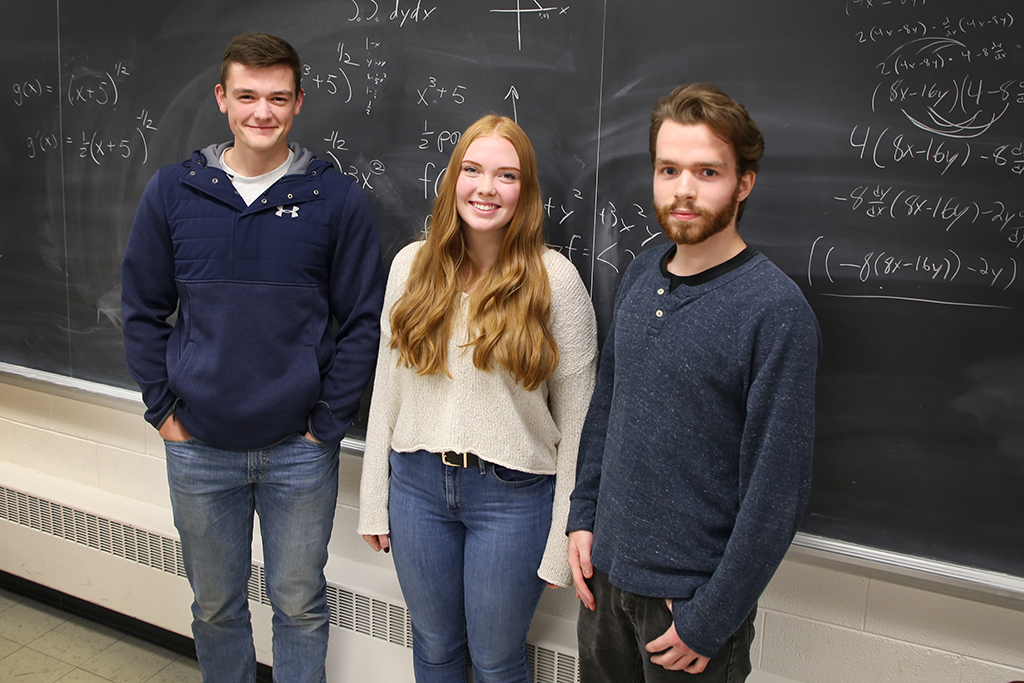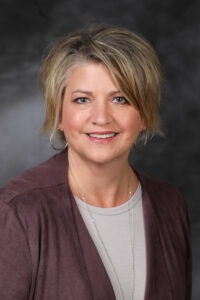UND math students go way beyond solving for X
Teams use critical thinking, statistical modeling to find real solutions for Grand Forks city planners

One problem plus one semester plus one heckuva lot of high-value experiential learning equals one very memorable academic experience, a trio of UND Mathematics students say.
Because while it may have started as a skimpy word problem just four lines long, the students’ work partnering with Grand Forks city planners led to a formula that could improve the local quality of life for years to come.
“It definitely wasn’t your traditional math class,” Associate Math Professor Jeremiah Bartz said of last spring’s “Math 460: Mathematical Modeling” course. “This arguably might have been the toughest homework problem they had to solve as undergrads but, hopefully, it also was the most rewarding.”
Plus, all the hard work that spilled into summer would come with a big bonus: an August trip to Philadelphia, where seniors Josh Canfield and Sierra Walker and junior Thomas Iken had the chance to present their work at a three-day math convention of Comic-Con proportions.
“It was really exciting to see how the mathematical mindset can be useful in so many different careers,” Canfield said. “I used to think, ‘Sure, a math major will help me figure out really fast how much I’m going to tip my delivery driver but not much more than that.’
“I hadn’t necessarily believed it, but this class really proved to me that math is a major where you can take all that you learn and apply it to multiple areas of expertise. Database management is just a step away. Analyzing data to come up with useful models is just another step away. It really was a crazy awakening and one I think every math major should experience.”

Making the connection
That’s the connection Bartz had hoped his students would make when he first challenged them last spring semester to apply their traditional textbook knowledge to some real-world research.
Earlier, Bartz and fellow Math Professor Ryan Zerr applied for and won a grant to take part in the Mathematical Association of America’s PIC Math program. Formally known as Preparation for Industrial Careers in Mathematical Sciences, PIC Math is designed to improve student abilities to problem-solve, communicate and think both critically and independently while partnering on a project with professionals in government, business or industry.
In this case, the partners were city planners with the Grand Forks Department of Community Development.
“I think UND is an incredible resource for the Grand Forks community. We have a lot of talent, and we grow a lot of talent,” Bartz said. “So, it’s a wonderful experience for students to blend our math expertise with the city. We can work together to help them find answers to some of the things they may have been curious about but either lacked the time or right mathematical skill set to explore.”
It all adds up to a win-win
Zerr, who also serves as associate dean of the College of Arts & Sciences, called the course and partnership with the city a win-win. Grand Forks gained valuable research with far-reaching impact, and the students gained additional skills — including an introduction to popular data science programs Python and R — as well as new perspectives on possible internships and career opportunities.
“Because the whole program is project-driven and collaborative, we had to come up with project ideas that would involve data analysis and also potentially help out our partners at City Hall,” Zerr said.
Four more teams in the class simultaneously were tackling their own data science modeling projects. The projects included everything from creating models for accurately estimating ongoing service costs such as street maintenance and leaf pickup to analyzing the ideal spatial distribution of schools, parks, police and fire stations in relation to neighborhoods. Yet another involved developing a method for analyzing residential and commercial properties with consideration for types of subsidies or incentive packages.
Digging for data
For team Canfield, Walker and Iken, the project meant sifting through piles of existing public data to create three statistical neighborhood models for Grand Forks’ Belmont Road using a technique called cluster analysis.
It’s complicated, but Iken explained it this way: By examining roughly eight development characteristics — such as the year houses were built, lot depth and effective lot frontage, and net land and building values — the students were able to group, or cluster, the sections based on common history and attributes.
And because the stretch of Belmont Road represents housing developments spanning from brand-new to more than a century old, city planners then, logistically, could use the same models to extrapolate data for “like” neighborhoods elsewhere in the city.
This would allow them not only to predict potential infrastructure upgrades — for example, upgrades for underground pipelines, roads, curb and gutter — but also compare house values and sizes to break down future maintenance costs relative to property size.
The project was extensive and included a lot of trial and error and back-and-forth conversations with instructors and city planners.
“We expected the students to be plugged in and attentive to the needs and constraints of their clients,” Zerr said. “When you’re exchanging a lot of technical information, you’re also learning how to be effective communicators — learning each other’s language — and honing all sorts of other value-added skills that naturally occur when you’re working in the real world but aren’t necessarily present in a typical math class.”
Long-lasting impact
Though the main assignment may have started with just a single paragraph, Bartz said the resulting research has the potential for a lasting, powerful impact on future city development.
In fact, he said, planners said the students identified a lot of factors they never before had considered.
The course already has made an impact on the students, too.
“One of the big things about employment, and especially in the tech world now, is that jobs are always changing, and the skills you need are ever-evolving,” Bartz said. “This course allowed students to be nimble, adaptable and creative, which is very atypical for math courses, which ordinarily focus more on technique and theory.
“The ability to take a complex problem, bounce ideas off one another and basically figure it out yourself is an extremely marketable job skill in today’s world.”
All three students echoed that sentiment, adding that the experience gave them either new direction or a specific career boost.
For Walker, the course was “definitely an amazing opportunity” that solidified her decision to begin pursuing her master’s in Data Science next year. And for Iken, it was a “career jumping point.”
“This was my first big accomplishment at the college level,” he said. “It may have been a lot of extra work, but taking the risk to pick up this elective was definitely rewarding. It’s something that’s going to stand out on my resume.”
And Canfield said he’s already seen proof of the same.
“I feel like this is my first real college accomplishment. I’m really proud of it, and I think any potential employer looking at what we did is going to be impressed,” he said.
Then, he added with a laugh, “I’ve told three potential employers so far, and all three clearly seemed to be impressed, so I guess it’s true.”



